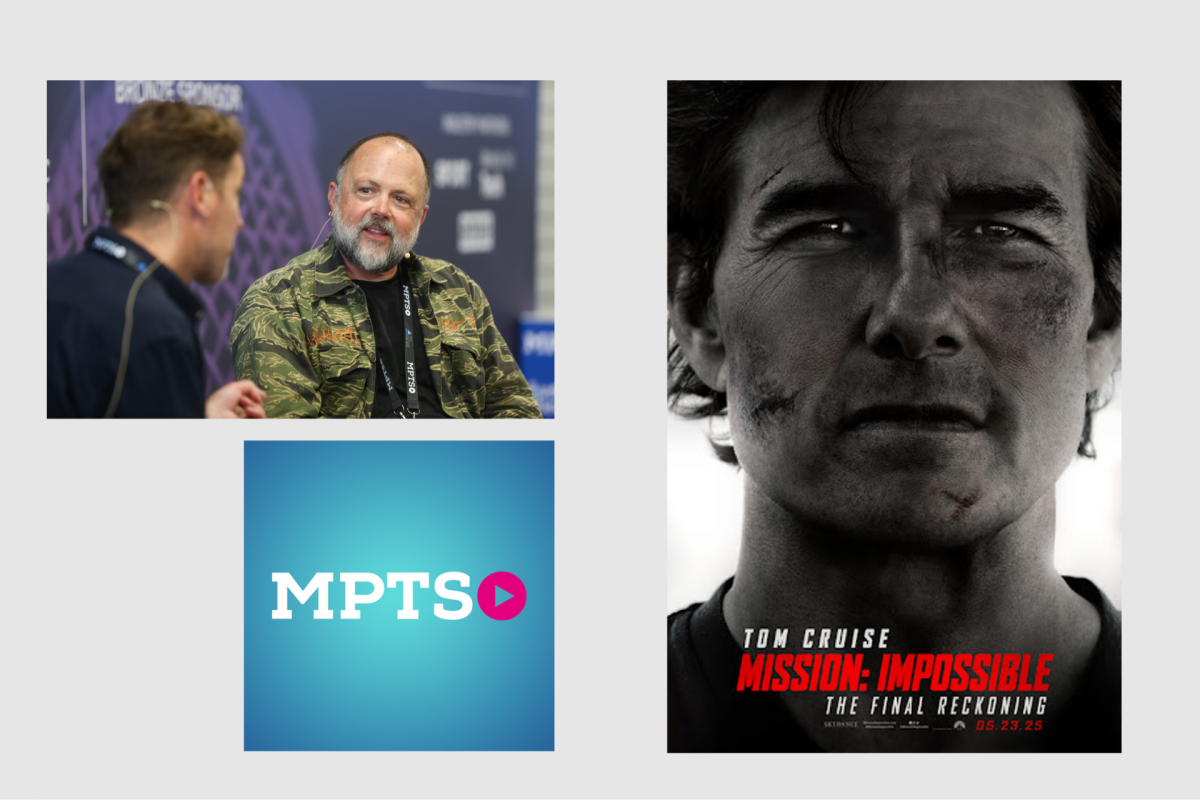In a career that has moved in distinct instalments from picture cutting rooms to the Vanity Fair party with a Best Sound Oscar in hand, James Mather has remained defiantly committed to one principle: clarity. Whether shaping the sonic fabric of Harry Potter, the troubles of Belfast or the sprawling, high-wire action of Mission: Impossible, Mather’s work is less about spectacle, and more about control, discipline and emotional impact.
Speaking to Resurface co-founder Ben Nemes at the 2025 Media Production and Technology Show, Mather offered a candid, insightful account of his craft and career. With the sound of Mission: Impossible – The Final Reckoning signed off just the night before, his reflections arrived fresh from the front lines of one of cinema’s most exacting workflows. Listen to the full 35 minute conversation on the link above, which is summarised below.
Defining the Job – and Then Redefining It
Mather is a Supervising Sound Editor, though he’s the first to admit the title is anachronistic. Originally a Stateside import, the label barely contains the breadth of the modern role. Today, it sits somewhere between sound designer, re-recording mixer, and producer—a pivot point connecting directors, editors and full sound teams across the post-production timeline.
He described his job as both managerial and creative, balancing responsibility for the overall sound vision with detailed involvement in its realisation. With DAWs now serving as both editorial and mix platforms, mixing is no longer a discrete phase; it begins early and happens continuously. For Mather, who handled temp dubs, pre-dubs and portions of the final mix on The Final Reckoning, this collapsing of roles is just the nature of contemporary post as a team sport.
Mather’s technical acumen wasn’t born in a university or training scheme. It emerged—somewhat accidentally—in a Bristol post-production facility that specialised in two formats with one thing in common: silence. With animation and natural history both being devoid of production sound, every element is built from scratch. There are no booms on set, no room tone, no sync—only footage and the requirement to make it tell the story.
That constraint turned into creative freedom. In Mather’s early years, he learned not only how to lay believable effects, but how to reinforce editorial rhythm and emotional pacing with audio alone. He recalls working for Aardman, where real conversations recorded in old people’s homes had to be reframed sonically into imagined environments. Those early years taught him not only the technicalities of track laying, but how to shape narrative with sound before the visuals were even finalised.
Escaping Picture, Embracing Audio
Though he started as an assistant in picture editorial, Mather cynically followed the money into the more lucrative world of audio 🙂 Sound was heading into the digital age first—and with it, more room for creative experimentation. Once digital systems like Fairlight appeared on the scene, he jumped ship from picture to audio.
A stint working as an assistant on Mad Max: Beyond Thunderdome in Australia gave him his first taste of high-stakes feature workflows. But it would be nearly two decades before he received his first full supervising credit on a major film. That break came back in the UK, with Aardman’s leap into feature territory.
When Chicken Run went into production around 2000, Mather found himself back in familiar territory, but this time with a bigger scope and a bigger toolkit. Operating out of a makeshift suite in a caravan parked on the Aardman stage, he embraced the challenge of long-form narrative in animation. His track-laying experience and deep familiarity with Aardman’s production style gave him a creative foothold—and his work didn’t go unnoticed.
Soon after came an invitation to join the Harry Potter franchise as it transitioned to a new director, David Yates. Mather arrived at film five (Order of the Phoenix) at a pivotal point. The story and characters had matured, and the sound would to evolve to match.
Redefining the Potter Sound
Taking over a project mid-franchise is never simple—particularly when the existing soundscape had been shaped by other respected designers. Mather found himself both inheriting and reshaping a world that was shifting tonally from childhood fantasy to adolescent conflict.
His brief, as he puts it, was to approach the material with “a fresh set of ears.” As the characters moved into their teens, so too did the sound. Less magical sparkle, more emotional depth; less whimsy, more weight. It was, he says, “the most collaborative but also creative process” of his career to that point. And it changed his trajectory—geographically and professionally. After years commuting from Bristol, he finally set up shop in London.
That job also brought him into contact with producer David Barron, who later introduced Mather to Kenneth Branagh. That relationship would lead to multiple collaborations, including that Best Sound Oscar nom for Belfast—a film requiring a wholly different sonic approach to tentpole fare.
Branagh’s directing style, Mather noted, is pragmatic and grounded. He brings a theatre ethos to film, valuing regular collaborators and trusting them to deliver without handholding. For Mather, that meant fewer explanations, faster iterations, and a deepening appreciation for the efficiencies that come from long-standing creative partnerships.
Entering the Cruise-McQuarrie Orbit
Another Barron-related project, Jack Ryan brought Mather into the orbit of Paramount’s post-production team—and eventually into contact with Christopher McQuarrie. When “McQ” took the reins of Mission: Impossible with Rogue Nation, Mather joined the franchise.
As with Potter, he was stepping into a franchise already in motion. But over time, he became a fixture. From Rogue Nation through Fallout, Top Gun: Maverick, and both parts of Reckoning (Dead and Final), Mather became deeply embedded in the Cruise-iverse.
The pressure, he says, is relentless. Cruise’s involvement has deepened over the years—not just as an actor, but as a producer immersed in the entire process. By The Final Reckoning, he was on set during the day and in the mix at night. There’s no off switch.
One of The Final Reckoning’s most ambitious sequences was an extended underwater set-piece. For Mather, it was a return to fundamentals: storytelling through atmosphere, rhythm, and sonic point of view.
The challenge was not just technical but conceptual. The sequence needed to shift between micro and macro perspectives—between claustrophobia and agoraphobia—while keeping the emotional thread intact. It required months of iteration, with multiple teams running alternate versions in parallel until picture locked. Some tracks were built purely from idea—before footage existed.
Ten Years, Four Films, One Philosophy
When asked by the audience how to balance competing sonic elements—dialogue, score, effects—Mather didn’t hesitate. The answer is always story. The best tracks, he said, are the ones that don’t overwhelm. “Less is more” isn’t a cliché in his hands; it’s a working philosophy.
He described a car chase from Rogue Nation as a moment where bikes were stripped of FX and score was pulled forward—because that’s what the sequence needed. By contrast, Dead Reckoning’s audio mix was constantly shifting. Music cues moved in and out of scenes late in the process. Foley tracks were cut if they interfered with narrative clarity. If it didn’t tell the story, it didn’t stay in.
Between Rogue Nation and The Final Reckoning, Mather has spent the better part of a decade inside the McQ-Cruise machine. The projects are vast. The hours are endless. But the core remains the same: sound must serve story.
The sheer duration of the productions—five years overall on Final Reckoning alone—demands a rare combination of endurance and adaptability. Every cut, every revision, every screening reshapes the final product. And the sound team must stay responsive without losing perspective.
Mather doesn’t claim magic. Just discipline, trust, and the ability to know when to stop adding. In a world where more is always possible, his strength is knowing what not to include.
Far from sounding like a man who has just emerged, blinking and broken from weeks in a loud, dark room, James seemed still to be contemplating how to make it better next time. Sadly, The Final Reckoning is the last instalment in the Mission:Impossible franchise. Or is it? “Never say never” grinned Mather.
With thanks to James Mather and the MPTS 2025



